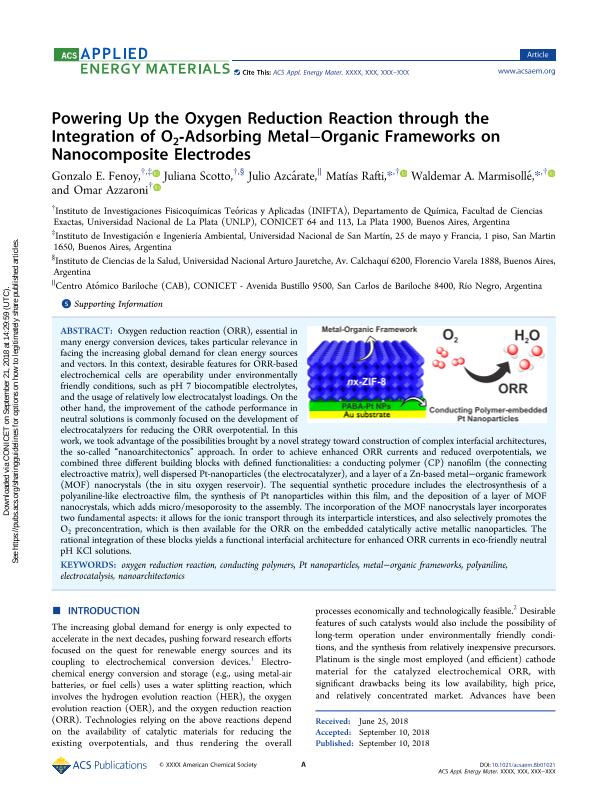Artículo
Powering Up the Oxygen Reduction Reaction through the Integration of O 2 -Adsorbing Metal–Organic Frameworks on Nanocomposite Electrodes
Fenoy, Gonzalo Eduardo ; Scotto, Juliana
; Scotto, Juliana ; Azcárate, Julio César
; Azcárate, Julio César ; Rafti, Matias
; Rafti, Matias ; Marmisollé, Waldemar Alejandro
; Marmisollé, Waldemar Alejandro ; Azzaroni, Omar
; Azzaroni, Omar
 ; Scotto, Juliana
; Scotto, Juliana ; Azcárate, Julio César
; Azcárate, Julio César ; Rafti, Matias
; Rafti, Matias ; Marmisollé, Waldemar Alejandro
; Marmisollé, Waldemar Alejandro ; Azzaroni, Omar
; Azzaroni, Omar
Fecha de publicación:
10/2018
Editorial:
American Chemical Society
Revista:
ACS Applied Energy Materials
ISSN:
2574-0962
Idioma:
Inglés
Tipo de recurso:
Artículo publicado
Clasificación temática:
Resumen
Oxygen reduction reaction (ORR), essential in many energy conversion devices, takes particular relevance in facing the increasing global demand for clean energy sources and vectors. In this context, desirable features for ORR-based electrochemical cells are operability under environmentally friendly conditions, such as pH 7 biocompatible electrolytes, and the usage of relatively low electrocatalyst loadings. On the other hand, the improvement of the cathode performance in neutral solutions is commonly focused on the development of electrocatalyzers for reducing the ORR overpotential. In this work, we took advantage of the possibilities brought by a novel strategy toward construction of complex interfacial architectures, the so-called "nanoarchitectonics" approach. In order to achieve enhanced ORR currents and reduced overpotentials, we combined three different building blocks with defined functionalities: a conducting polymer (CP) nanofilm (the connecting electroactive matrix), well dispersed Pt-nanoparticles (the electrocatalyzer), and a layer of a Zn-based metal-organic framework (MOF) nanocrystals (the in situ oxygen reservoir). The sequential synthetic procedure includes the electrosynthesis of a polyaniline-like electroactive film, the synthesis of Pt nanoparticles within this film, and the deposition of a layer of MOF nanocrystals, which adds micro/mesoporosity to the assembly. The incorporation of the MOF nanocrystals layer incorporates two fundamental aspects: it allows for the ionic transport through its interparticle interstices, and also selectively promotes the O 2 preconcentration, which is then available for the ORR on the embedded catalytically active metallic nanoparticles. The rational integration of these blocks yields a functional interfacial architecture for enhanced ORR currents in eco-friendly neutral pH KCl solutions.
Archivos asociados
Licencia
Identificadores
Colecciones
Articulos(CCT - PATAGONIA NORTE)
Articulos de CTRO.CIENTIFICO TECNOL.CONICET - PATAGONIA NORTE
Articulos de CTRO.CIENTIFICO TECNOL.CONICET - PATAGONIA NORTE
Articulos(INIFTA)
Articulos de INST.DE INV.FISICOQUIMICAS TEORICAS Y APLIC.
Articulos de INST.DE INV.FISICOQUIMICAS TEORICAS Y APLIC.
Citación
Fenoy, Gonzalo Eduardo; Scotto, Juliana; Azcárate, Julio César; Rafti, Matias; Marmisollé, Waldemar Alejandro; et al.; Powering Up the Oxygen Reduction Reaction through the Integration of O 2 -Adsorbing Metal–Organic Frameworks on Nanocomposite Electrodes; American Chemical Society; ACS Applied Energy Materials; 1; 10; 10-2018; 5428-5436
Compartir
Altmétricas



